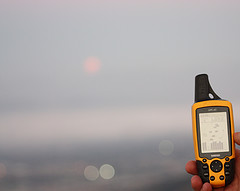Best Handheld GPS
 Whether you’re an avid traveler, backcountry superstar or just a fan of new gadgets and geocaching, you may be looking to purchase one of the very best handheld GPS to help you attain your goal of always knowing where you are and never getting lost, no matter where you are.
Whether you’re an avid traveler, backcountry superstar or just a fan of new gadgets and geocaching, you may be looking to purchase one of the very best handheld GPS to help you attain your goal of always knowing where you are and never getting lost, no matter where you are.
However, finding the best handheld GPS these days is no easy feat. With the rising popularity of geocaching, and more generally using GPS devices instead of good old maps, the entire market boomed. Today, dozens of companies make handheld GPS devices so there are now hundreds of models to choose from. The sheer number of devices can make choosing the right model a daunting task for the first time GPS buyer.
There are also dozens of new features and mysterious abbreviations that show up in sales letters and catalogs, meaning you may find yourself with more questions about handheld GPS models after researching them than before.
There are a few key features you should look for before setting out and purchasing your GPS. That being said, most will tell you that Garmin is the ONE when it comes to handheld GPS. They produce the highest quality, sturdiest and most reliable systems (I in no way represent Garmin, that just seems to be the general consensus among consumers).
Features to Consider Before You Buy a Handheld GPS:
Battery life – This one’s simple. A dead GPS won’t do you much good and you don’t want your GPS to die in the middle of nowhere. Look for a battery life of at least 12-15 hours.
Map coverage – Not all handheld GPS models show an actual map, but rather just coordinates and maybe the distance and direction of a waypoint. Personally, if I’m going to spend a few hundred dollars on a GPS, I don’t have to take a paper map with me. I want to see where am I, not just a mysterious number like 27°10’0N;78°2’60E. The maps usually come on SD or xD cards, but some models have built-in memory.
Number of channels – This number (usually 12-24) represents the number of satellite signals the handheld GPS system can track simultaneously. The more satellite signals you receive, the more precisely your position is tracked, and the more likely you are to have coverage even under canopy or in canyons.
Tracks feature – This definitely isn’t a necessary feature, but it sure is a nice one. Most GPS systems store the trail you’ve walked. More expensive devices can usually store multiple very long trails, which you can download to your PC as well. This way you can document, and later prove, what a backcountry badass you really are.
Weight and size – Obviously, if you are purchasing a handheld unit, you want a GPS that is small and lightweight. Keep in mind most of the weight is made up by the batteries, so a higher battery life means a higher weight as well. Consider this before buying, but also keep in mind most units only vary a few grams.
High battery life, extendable map coverage, great trail storage capacity and small weight – these are the most important attributes and features of the best handheld GPS systems.
Looking to buy one? Here are the Bestselling Handheld GPS Models:
Geocaching
Backpacking/Hiking
- Garmin 60CSx Review (Buy)
- Garmin Colorado 400t Review (Buy)
- Garmin Oregon 400t Review (Buy)
- Garmin Oregon 300 Review (Buy)
- Garmin Forerunner 405 HRM Review (not technically handheld, but a wrist/watch GPS) (Buy)
GPS with SPOT Satellite Messenger
Photo by Blyzz on flickr